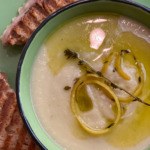

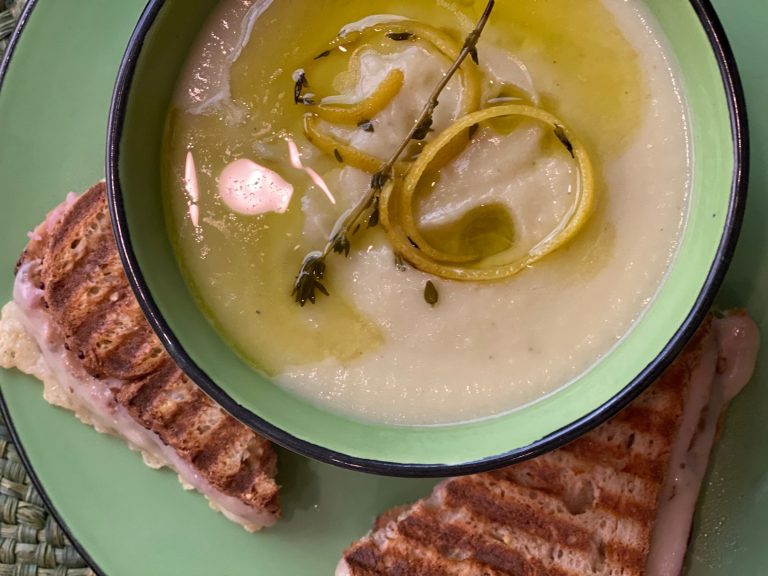
Happy New Year 2021 to every living soul on earth. Congratulations for making it through the myriad of 2020 curveballs. Many of us are hurting, have suffered illness, loss, and financial distress, confusion, disenfranchisement, or have waited long generations for justice. Yet here we are. That is something to celebrate.
Today is a good day to renew our courage and strength. Keeping ourselves and others sustained, encouraged, warm, fed and filled with good humor is no small task, but it is ours. Are you up for it?
A hot bowl of soup sends a message: I'm Ok. Are you Ok? I'm here. Together we'll keep our chins up. You are important. I am glad for you in my life. Take nourishment.
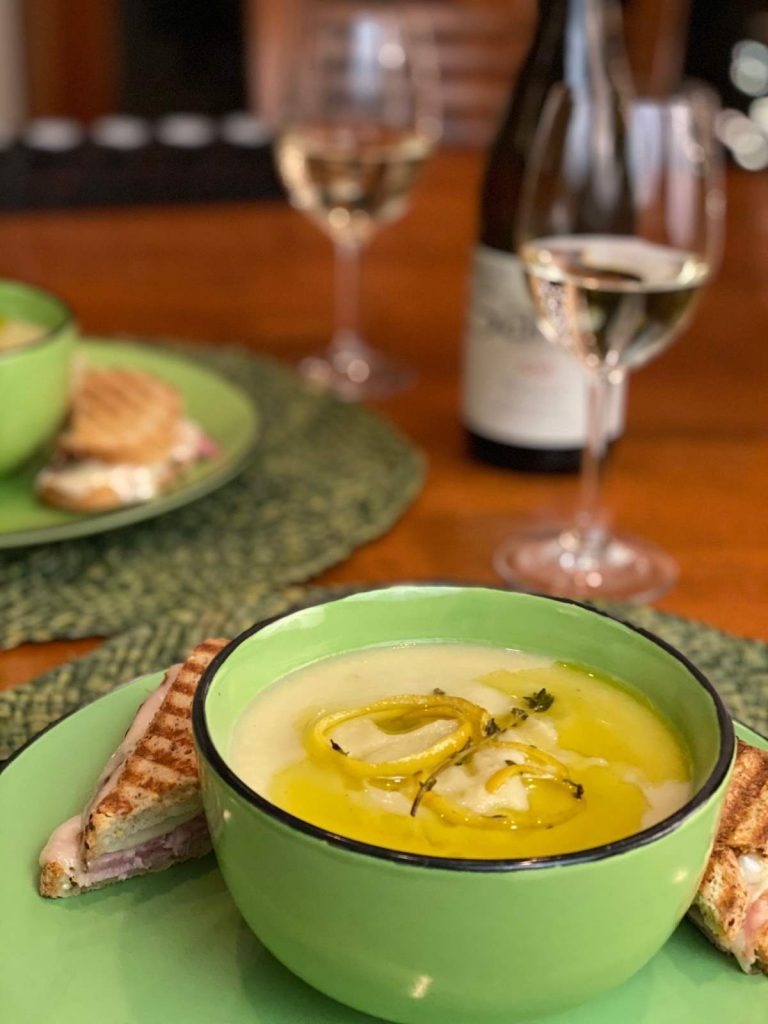
Yes, all this in a simple bowl of soup.
This elegant looking white soup simply used a bunch of white and palest green use-it-or-lose-it vegetables in my fridge. The guidelines you're about to read will work for nearly any vegetable or combination of vegetables for a flood of delicious soup options. Following these simple rules of thumb, you can have a creamy but cream-less pureed soup once a week all winter long and never grow bored. The same goes for the herbal drizzle. This really is a choose-your-own-adventure bowl of goodness.
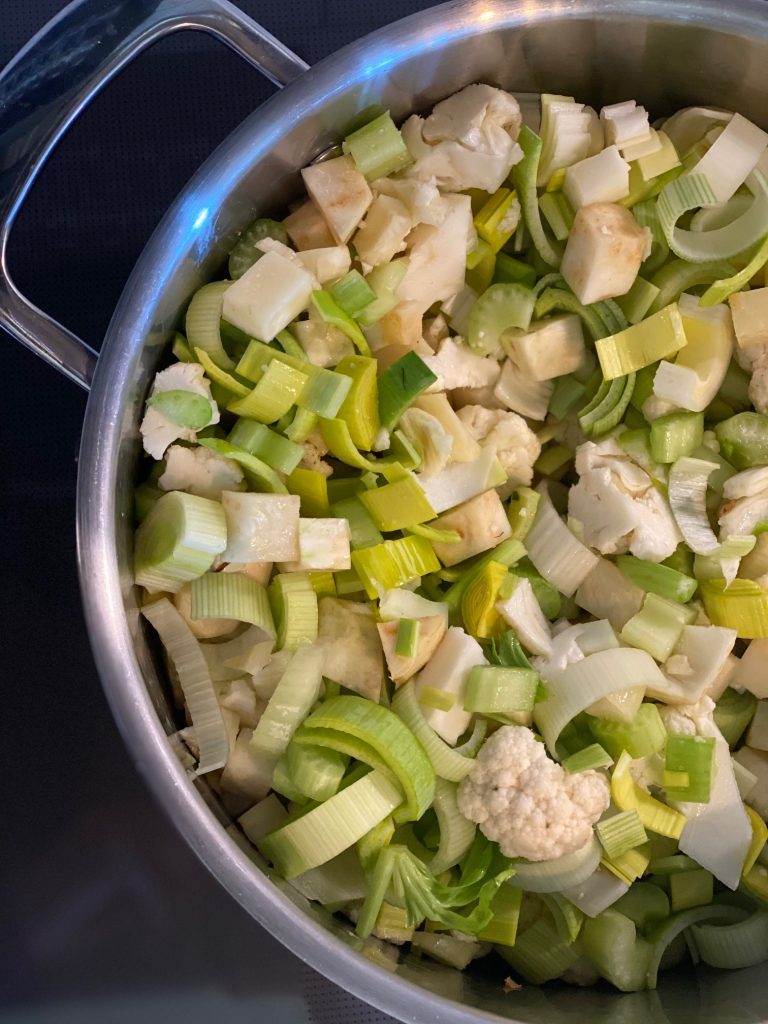
Step One: Gather, clean and roughly chop a bunch of vegetables from your bin. This is a great time to use up those that have been languishing. Choices include, but are not limited too:
roots like carrot, beet, turnip, parsnip, rutabaga, ginger, fresh turmeric
celery, fennel, celeriac (celery root)
onion, leek, shallot, garlic
potato, sweet potato
fresh or frozen peas or corn
peppers
winter squashes, like butternut and pumpkin
summer squashes
greens like kale, chard, mustard, spinach, collards, cress, etc.
fresh or canned tomatoes
brassicas like cauliflower, broccoli, cabbages, Brussels sprouts, kohlrabi, etc.
The featured soup used a small head of cauliflower, one celeriac, one fennel bulb, four stalks of celery with leaves, and about a cup of leftover mashed potatoes added during the simmer.
Your soup can be all one vegetable, a triad (corn, poblanos, and potato is amazing!) or a mélange like this winter white soup-- cauliflower, leek, celeriac, celery, and potato in the form of leftover mashers. Use your imagination and what you have on hand. There are no rules. (Except, purple veggies tend to turn an unappetizing gray when cooked this way. You may want to avoid purple carrots and cabbage.)
Quantity doesn't matter; you're going to be working in loose ratios. If you use a lot of vegetables, you'll make a bigger pot of soup. It's as simple as that.
Step Two: Plop your prepped veggies into a pot and give them a brief sauté in your favorite cooking oil or fat. Some choices are:
OVOO (extra virgin olive oil)
Ghee or butter
Reserved bacon fat (adds a smoky quality to the soup.)
Coconut oil
Add salt as you are sautéing, and pepper too. Layering in salt makes finished dishes so much better than waiting until the end. Vegetables demand salt, so give them what they want!
What size pan? If you have a small amount of vegetables, a three-quart saucepan may be just right. If you're aiming to feed a crowd or to have leftovers for lunches, think in terms of a six or eight quart, or even larger, stockpot. Give yourself some headspace if you'll be blending right in the pot, see below.
How much fat do you want to add? Good question! Don't be shy. Fats are highly maligned yet essential. Fats are what make your vegetable-based soup filling and satisfying. And here's the big secret for this soup-- it's a fair amount of fat that gives your blended soup a creamy texture, mouthfeel, and look.
To get more specific, make sure that the bottom of your pan is well-coated with your choice of oil or fat. An eighth-inch or so will be great. You can always add more for flavor or creaminess later.
How long, and at what heat? Sauté the veggies over medium heat until they are beginning to soften. Since you are using a deep pot, they will actually steam as much as sauté. This is perfect-- steaming begins to break down the cell walls, and the veggies will begin to sweat. Keep at this, stirring occasionally, until they are just beginning to become tender. This will be 10 minutes or so for a small pan; up to 20 minutes for a large one.
Step Three: Barely cover the vegetables with cooking liquid, cover, and simmer. Add liquid to just come to the top of the vegetables. If in doubt, use a little less-- you will adjust the thickness of your soup later. Here are some good choices for cooking liquid:
Water (So many recipes like this call for stock. Nothing wrong with that, but I love the pure vegetable flavor to shine out. I use water 90% of the time when I'm making these pureed soups, and reserve precious stock for other types of soups and stews.)
Stock (see above.)
A can of coconut milk, along with enough water to just cover the vegetables. (This is especially good with winter squashes and a spoonful of Thai curry paste, garam masala, or madras curry powder.)
A little wine, red or white, in addition to one of the above.
With certain vegetable choices, tomato juice will work, too.
Step Four: Simmer, stirring every five minutes or so, until the vegetables are fully tender and a fork can be somewhat easily inserted. If I'm using hard vegetables like turnips, parsnips, and celeriac I give this up to 30 minutes, less time for the tender ones.
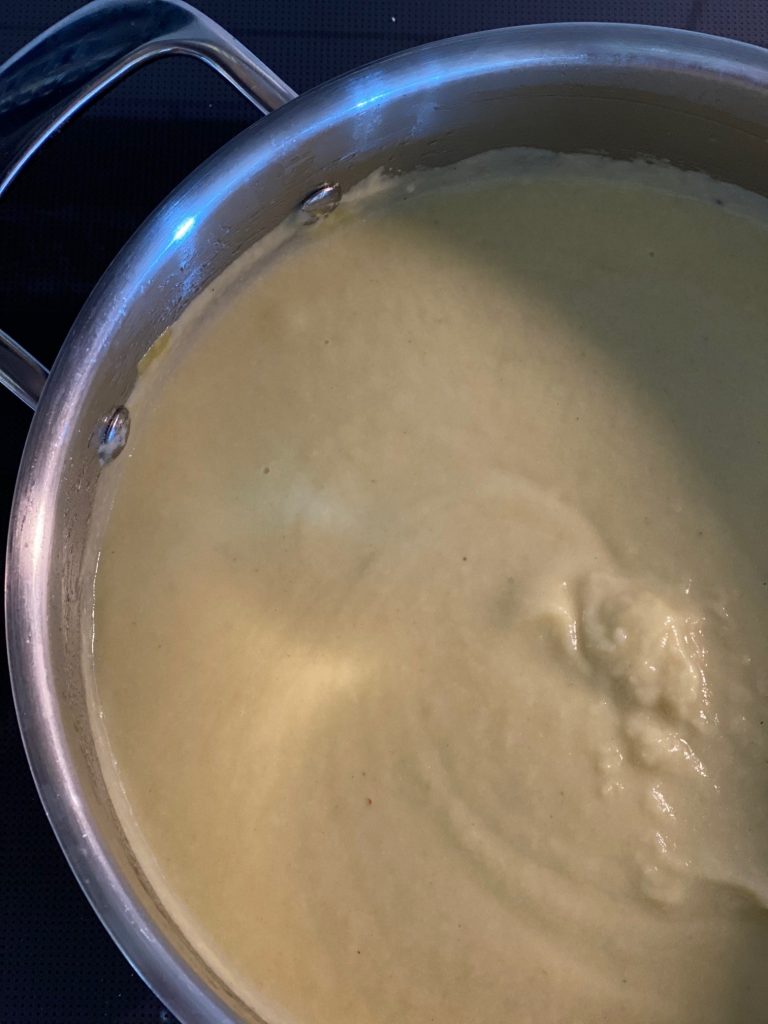
Step Five: Blend the vegetables with an immersion blender (my favorite,) or in a blender or food processor until completely smooth and no lumps remain. An immersion (stick) blender makes this fast, easy, safer, and with less clean up. If you love this type of soup like I do, you will want to get one if you don't already have one.
You’re going for a consistency slightly thicker than heavy cream. Add more of your cooking liquid or water in small amounts until it gets there. Without enough liquid, you'll have difficulty getting your soup smooth and lumpless. On the other hand, if your soup seems too thin let it continue to simmer and reduce at medium-low heat, stirring very often-- the pureed soup spews bubbles all over your stovetop as it heats, so stir ever one minute or so-- until it thickens up.
Now is a good time to taste for salt and pepper and make adjustments.
For the Lemon Thyme Drizzle, and other fun ways to jazz up a pureed vegetable soup:
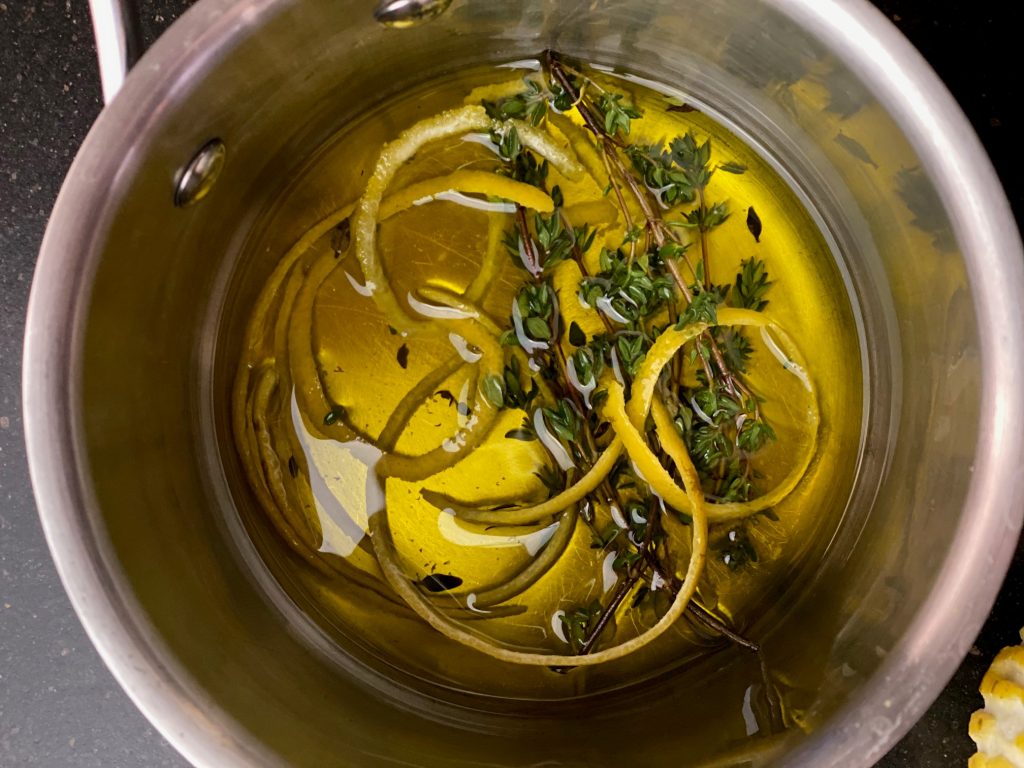
Step One: While your vegetables are sautéing and simmering, in a small saucepan pour 1/4 cup EVOO. Add your choice of fresh herbs. My favorites are:
thyme
rosemary
basil
tarragon
dill
Add some citrus strips or grated zest. Lemon, orange, and lime all are great, depending on the vegetables you use. The citrus adds a bright lift to the finished dish.
Step Two: On very low heat and stirring occasionally, let this gently steep while the soup is coming together. Right before serving, strain it, reserving pieces of zest and any whole herbs that look pretty as a garnish.
Use any leftover fancy oil in salad dressings or sautes. No need to waste a single drop of this flavor booster.
Other great ways to dress up a pureed soup:
A handful of roughly chopped nuts-- hazelnut, almond, walnut are especially good.
A dab of sour cream or creme fraiche.
A handful of croutons made from day-old bread tossed in a little oil and garlic and/or herbs as toasted in the oven for 5-8 minutes.
Or just a scattering of fresh minced herbs and a swirl of olive oil.
Plate up your soup while it is hot, and garnish away. Enjoy experimenting with various vegetables, herbs, oils, and toppings. Trust your intuition!
Blessings on your 2021. Be well, brave, and strong. Get plenty of sleep. Find ways to renew your courage. Take time out. Reach out. Make soup.
